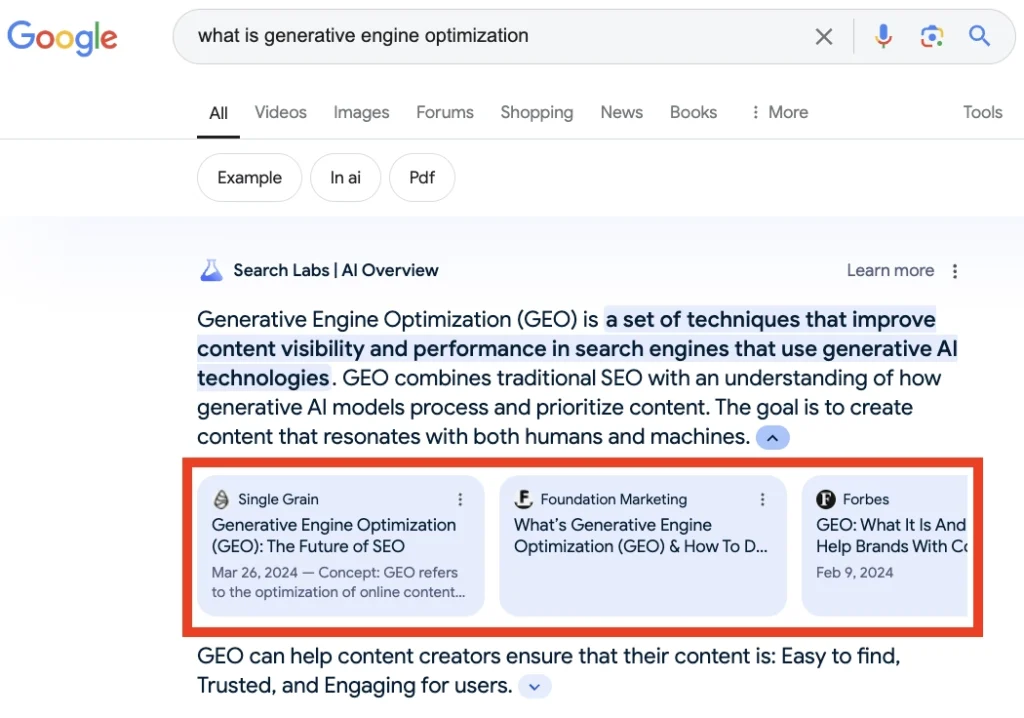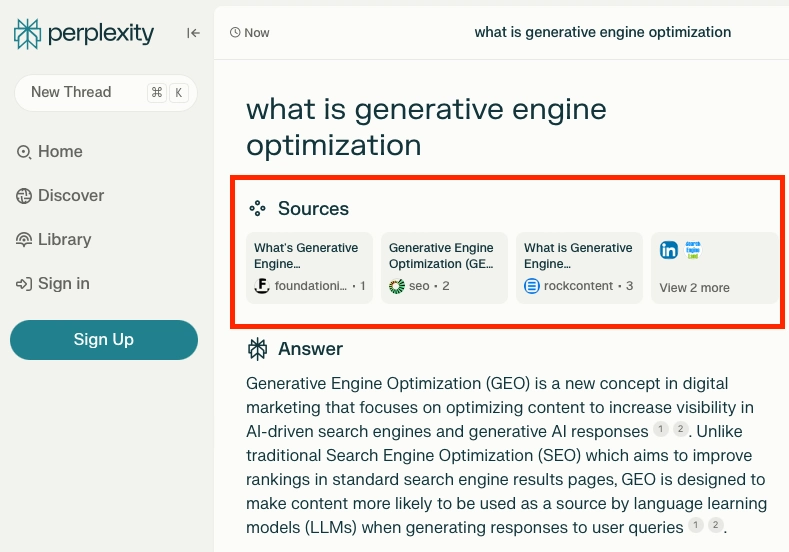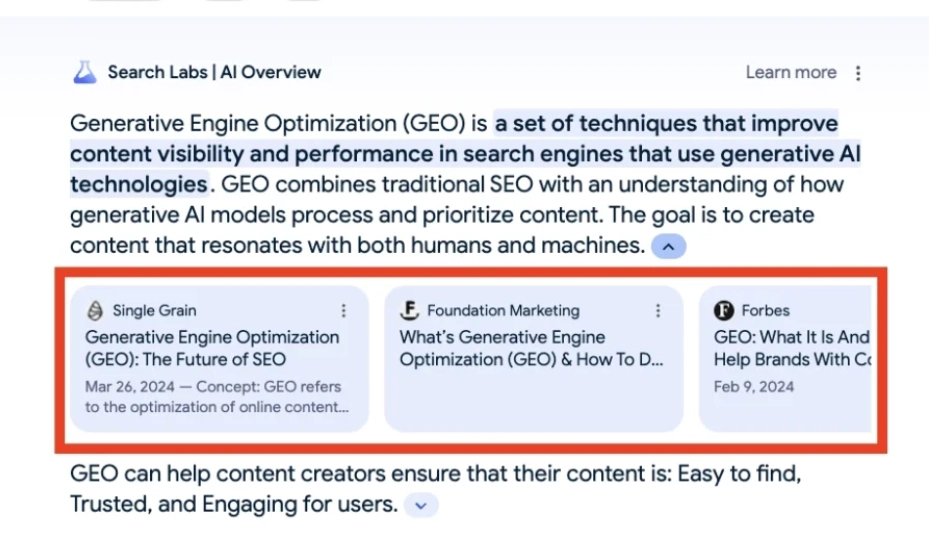Table of Contents[Hide][Show]
In the ever-changing world of search, generative engine optimization (GEO) is a new way to find content. This article will break down GEO and explain how it uses AI to go beyond SEO. You’ll learn how GEO can help your content strategy and the key differences from previous optimization methods.
Key Insights
- Generative Engine Optimization evolves SEO into optimizing for AI-driven search engines by prioritizing content quality and relevance to the specific needs of generative models, potentially increasing visibility by 115.1%.
- Balancing SEO and GEO is crucial. SEO is for traditional search engines, while GEO is for AI-driven engines, so you need an updated approach that includes high-quality, authoritative content. Understanding and implementing both is key to a successful online marketing campaign.
- The future of digital marketing is towards GEO, using AI tools and predictive analytics for content strategy and keeping SEO and GEO in sync with the changing search landscape.
- GEO can help with local search rankings by optimizing for local search queries.
Understanding Generative Engine Optimization (GEO)

In digital marketing, Generative Engine Optimization (GEO) is a new paradigm for increasing content visibility in AI-driven search engines. These engines aggregate information from multiple sources to produce answers; they are a game changer in the world of online search. With GEO evolving so fast, marketers need to adapt to the requirements of these AI-powered generative engines.
But how does Generative Engine Optimization (GEO) fit with traditional SEO? The answer is in its content optimization approach. Generative SEO goes beyond conventional SEO techniques, including practices designed for generative AI models. This hybrid approach will increase the prominence of your content in AI-curated search engine results. Using geographical keywords in GEO can target local search queries and increase visibility in local search results.
Now, let’s examine Generative SEO in more detail, including how it differs from SEO and its impact on search results.
The Basics of Generative Engine Optimization
Often called the “next level” of Search Engine Optimization, GEO is about optimizing online content for better visibility and performance in generative search that uses generative AI. Generative SEO aims to understand how AI reads and prioritizes content. Adjusting your online content to match generative AI can increase your visibility in AI-generated search engine results. Community conversations play a significant role in GEO by engaging with local audiences and content relevance.
But GEO isn’t just about visibility; it’s about prominence. Generative AI technologies read and prioritize information differently than traditional search engines. By understanding these differences and adjusting your content accordingly, you can gain a big advantage in the AI-driven search landscape.
GEO vs. SEO: Key Differences
Many marketers wonder how GEO differs from SEO. The main difference is in their content optimization approach. Both are about increasing your online presence but focus on different parts of the process. Traditional SEO is about keyword density and backlinks to rank your site. Generative AI SEO is about content quality, relevance, and being able to answer user queries directly.
Additionally, GEO is designed to target AI-driven search engines, aligning your content with the needs of generative models. In contrast, SEO is oriented toward optimizing websites for traditional search engines. This shift from keyword-centric strategies to a focus on the overall quality and directness of content is a key difference between GEO and SEO. Moreover, the use of geo-targeted citations in GEO can significantly improve local search visibility and relevance.
The Impact of GEO on Search Engine Results (SERPs)

What can you expect from GEO? Research shows that GEO can increase content impressions by 30% in AI-driven search landscapes. In some cases, websites that were 5th in search results saw a 115.1% increase in visibility after optimizing for AI-driven search.
How do we measure this? The answer is in impression metrics. These metrics are designed to measure the visibility and relevance of content in AI-generated search results so you can see how effective your GEO strategies are. Your CTR (click-through rate) is essential as it tells you how often users engage with your content after seeing it in search results. By including authoritative sources and clear language, you can adjust your content to match the criteria of generative search engines and increase its visibility.

As you can see in the examples above (Google AI Overviews and Perplexity), AI aims to provide the best answer right away and cite websites as “ranking sources.” Given AI’s goals and nature, we may find impressions going up, but how will that truly impact traffic as AI search engines continue to be adopted and improve over time?
Crafting Content for AI Search Engines (Generative Search Engines)

Now that we understand generative engine optimization (GEO) and how it differs from SEO, let’s dive into the content creation process for generative search. To ensure these engines understand your content’s search intent, you need to provide clear and specific prompts that guide the generative models without ambiguity. Including local terms in GEO can increase content relevance for local searches.
New Generative SEO strategies like comprehensive content can get better responses from conversational AI and can increase the rankings of lower-ranking websites in AI-driven search engine experiences. Let’s look into authoritative, data-driven content and the role of language and clarity in AI content generation.
Authoritative and Data-Driven Content
In GEO, authority is critical. This is based on E-E-A-T (Expertise, Experience, Authoritativeness, Trustworthiness) in your content. But how can you make your content look authoritative? The answer is in data and statistics.
Data and statistics are the backbone of your content claims. This increases content trustworthiness and quality for generative AI search engines. Quoting experts and citing sources effectively get generative AI to recognize content. Including geographical elements in data-driven content can increase local search visibility in GEO.
To optimize for generative AI, stop focusing on keyword density and start incorporating authoritative elements like expert opinions. This is key to building trust and visibility in AI-driven search results.
Language and Clarity in AI Content Creation

Clarity is essential when creating content for AI-driven search engines. Here are some tips:
Leverage natural language processing to understand the context of your content over keyword density.
Emphasize the informative and engaging nature of your content.
Use natural language and conversational phrases to make your content understandable and relevant to AI-driven search engines, while also considering keyword difficulty.
But how can we achieve this clarity? Here are some tips to make your AI-generated content more human-like:
Use a conversational tone
Use everyday language
Ask questions to engage your readers
Avoid jargon and technical terms in favor of everyday language
Following these tips can make your content more readable and perform better with AI search engines. Clear content is critical to improving local search rankings, especially in GEO.
It’s also important to maintain clarity and prevent generative AI from producing monotonous content by varying sentence length and structure, avoiding overuse of complex terms, and using concise prompts that avoid ambiguity in AI content creation.
Integrating GEO with Your Current Search Engine Optimization Strategy
Now that you understand GEO and its content optimization approach, you might be thinking, “Should I abandon my current SEO strategy for GEO?” Not so fast! You need to integrate GEO with your existing SEO practices to maximize your digital presence across all search engines.
By using both SEO and Generative Engine Optimization, you can cater to both traditional and AI-driven search engines and improve your overall search presence. Let’s look into striking a balance between SEO and GEO and how to measure success across both. One key metric to measure the success of these integrated strategies is organic conversion rates, which is how well your efforts are converting visitors into customers.
Balancing SEO and GEO Techniques
When it comes to content optimization, balance is essential. While you need to be ahead of the curve using Generative Engine Optimization, you can’t ignore traditional SEO.
By striking a balance between AI SEO and traditional SEO, you can optimize your online SEO content for success. Optimizing for mobile traffic is also important in both SEO and GEO, as more users are accessing content via mobile.
The key is to balance search engine optimization (SEO) and GEO. By combining the best of both, you can take a holistic approach to content optimization that caters to all types of search engines, both traditional and AI-driven.
Measuring Success Across SEO and GEO
As with any marketing strategy, you need to measure the success of your SEO and GEO. For SEO, key metrics are organic traffic volume and organic conversion rates, which are the foundation of measuring the quality of SEO traffic and the performance of your SEO strategies. Regularly tracking keyword rankings, the number and quality of backlinks, mobile traffic, and other engagement metrics like bounce rate and time on site is essential to monitor your SEO efforts’ overall direction and success.
Success in local markets can also be measured quantitatively through the tactical use of geographical keywords and how well they engage with community conversations. For GEO, success is measured by:
Local search rankings
The volume of organic traffic from local searches, also known as search volume
User engagement metrics such as click-through rates from local search engine rankings
The visibility of geo-targeted citations
Leveraging AI Tools for Enhanced SEO and Generative SEO

As we dive deeper into GEO, the importance of AI in SEO becomes apparent. AI can help SEO by analyzing and generating content with keywords and hashtags. For GEO, AI helps with keyword research, including local terms and geographical elements in content. Using AI for SEO, we can optimize our online presence and better reach our audience.
But AI tools aren’t just for keyword research. They also play a significant role in monitoring and fixing technical SEO issues like crawl errors and page speed. These are important to your search rankings. AI tools can identify and fix crawl errors so search engines can index your site. Let’s dive deeper into how AI Marketing technology can help and the role of predictive analytics in content strategy.
AI SEO Technology for Efficiency
You can tap the power of artificial intelligence to boost your SEO. AI SEO tools have many features:
Identifying optimization opportunities
Prioritizing recommendations
Suggesting content topics
Outlining content
Offering keywords and technical improvement recommendations
AI tools can also fix technical SEO issues and overall SEO performance.
These tools help in strategic content planning, including crafting meta descriptions, and can supercharge your SEO.
AI-driven SEO platforms offer several benefits for bloggers, including:
Creating high-ranking blog posts by leveraging competitor analysis insights
Employing natural language processing to optimize content
Crafting copy for various marketing initiatives, such as blog posts, emails, and social media updates
Offering multilingual support to cater to diverse audiences
These can supercharge your blog post creation and reach a bigger audience.
Predictive Analytics in Content Strategy

Predictive analytics is another tool in the SEO and GEO arsenal. Using historical data, statistical algorithms, and machine learning, predictive analytics can inform content strategy decisions. AI SEO tools can use predictive analytics to predict market trends and user behavior, and you can optimize your content accordingly.
Regression analysis is often used in predictive analytics to identify key variables for content optimization. By understanding and predicting user interests and search patterns, you can better tailor your content to user needs and increase user engagement. Predictive analytics also helps SEO professionals forecast search engine algorithm updates so they can adjust their strategy ahead of time.
Advanced Techniques in GEO
As with any growing field, GEO introduces new techniques to optimize content. One of those is Schema Markup, also known as Structured Data. This vocabulary helps AI-driven search engines understand your website content better and show better search results with rich snippets.
Knowledge graphs built using Schema Markup help AI better understand entities and their relationships and improve search matching. A/B testing in GEO can also optimize content and user engagement. Let’s dive deeper into how structured data and machine learning can help your GEO.
Utilizing Structured Data for GEO
Structured content with clear headings, subheadings, and lists can make your content more readable for AI-driven search engines. But structured data goes beyond that. It also improves the quality of information available for generative AI, so consistency and accuracy are important for training good models.
Structured data helps find relationships between different types of information, which is essential for predictive modeling and finding complex data correlations. Predictive modeling uses structured data to improve AI-driven search results. Structured data not only supports the scalability and reusability of AI models but also helps search engines understand content marked up with schema, which results in better content matching with user queries.
Machine Learning’s Role in Content Optimization
Machine learning algorithms in GEO detect relevant keywords, phrases, or topics that match user queries. These algorithms can then generate new content for searchers. Content optimization through machine learning in GEO is about creating a better user experience by generating more content that drives engagement and conversion.
Moreover, machine learning helps identify the most important variables for SEO and content optimization through regression analysis and A/B testing. Statistical algorithms are also used in machine learning to optimize content for GEO. By understanding these variables, you can fine-tune your content strategy to get the most out of your SEO and GEO.
The Future of Digital Marketing with GEO
GEO is inevitable in the future of digital marketing. Because of its AI-driven approach to content generation and search engine behavior, GEO can be more powerful than traditional SEO. Industry experts discuss embracing GEO strategies and emphasizing AI and machine learning in digital marketing.
However, the future of online marketing with Generative SEO is speculative and requires continuous learning and adaptability in the marketing community. Given the fast pace of digital marketing, professionals need to stay updated with the latest trends and techniques in GEO. Attending AI Masterclasses is essential to stay updated with the newest developments and methodologies in GEO. Let’s dive into how to stay ahead with GEO knowledge and the combination of SEO and GEO in future marketing strategies.
Staying Ahead with GEO Knowledge
To stay ahead in digital marketing, you must update your GEO knowledge. You can do that by attending AI Masterclasses, following industry experts, and staying updated through research papers and AI newsletters.
To reinforce your knowledge and expertise, apply what you have learned about GEO to real-world scenarios. That way, you will better understand and utilize Generative SEO and adapt your strategies to the ever-changing industry.
The Synergy of SEO and GEO in Future Marketing Strategies
To have effective online marketing strategies, you need to combine the best of both SEO and GEO. That way, you can adapt to the evolving AI-driven search landscape and make your content visible and relevant across all search engines.
While GEO is becoming more important, a blend of traditional and generative search that uses both SEO and GEO expertise will define the future of online marketing. So, digital marketers should continue to combine SEO and GEO practices to have holistic strategies that are in line with the trends and developments in search technology. Stay updated with search engine algorithm updates to adapt your SEO and GEO strategies.
Summary
In summary, Generative Engine Optimization is a must-have tool in online marketing. By understanding and utilizing the power of AI-driven search engines, you can generate more engaging, relevant content that stands out—and get more visibility and engagement. GEO also makes your content visible in AI-curated search results so your content reaches the right audience. Whether you are an SEO expert or a digital marketer, you should start embracing GEO now. So what are you waiting for? Dive into GEO and start transforming your digital marketing now!
Frequently Asked Questions
What is Generative Engine Optimization (GEO)?
Generative Engine Optimization (GEO) is the process of optimizing online content to increase its visibility and performance in search engines that use generative AI. It’s about tailoring content to how generative AI models understand and prioritize it.
How does Generative Engine Optimization improve content visibility?
GEO optimization increases visibility by increasing impressions and adhering to search engine criteria, 30% on average. So, adapting content to those criteria will make it perform better in search results.
What is the difference between GEO and SEO?
The main difference between GEO and SEO is that GEO optimizes content for AI-driven search engines, while SEO focuses on traditional search engines.
Can Generative Engine Optimization and SEO be used together?
Absolutely, using both GEO and SEO together is recommended to boost visibility across various search engines.
What are the benefits of incorporating GEO into my online marketing strategy?
Including GEO in your marketing strategy can provide several benefits, including increased content visibility in AI-driven search landscapes, higher engagement rates, and greater reach for your content. By understanding and matching the requirements of generative AI technologies, your content will be more likely to be featured in search recommendations and give you an edge in the digital space.

 Top Digital Marketing Companies in the US for 2024
Top Digital Marketing Companies in the US for 2024